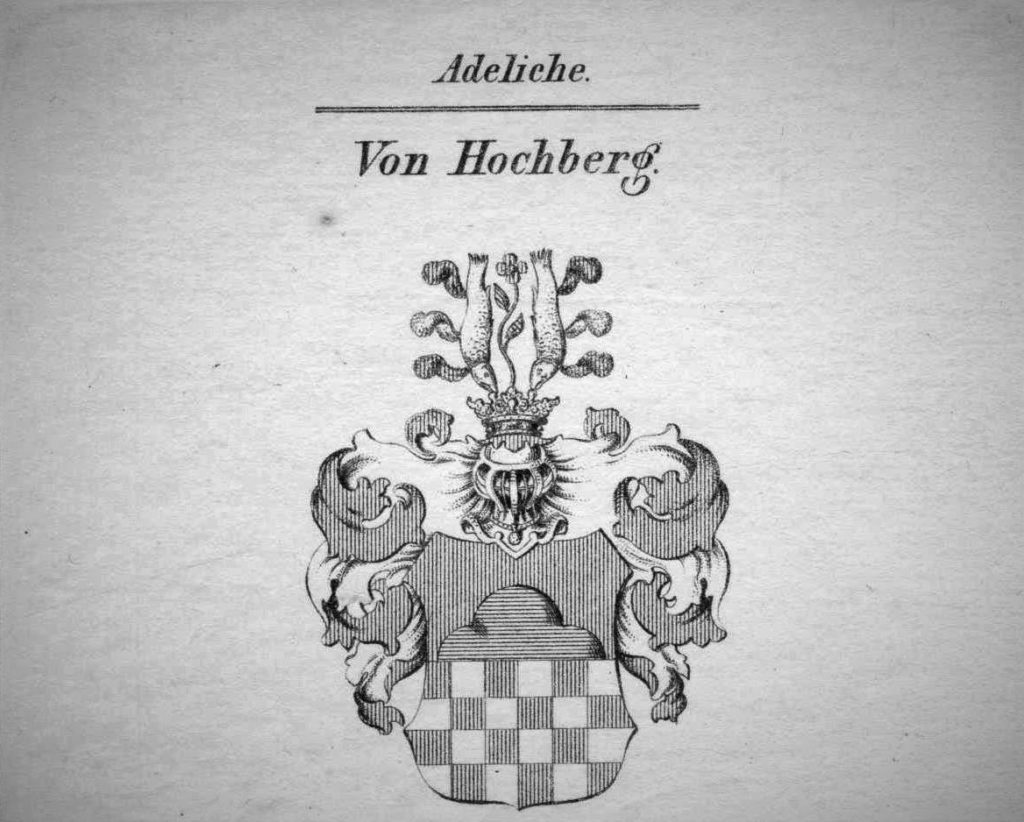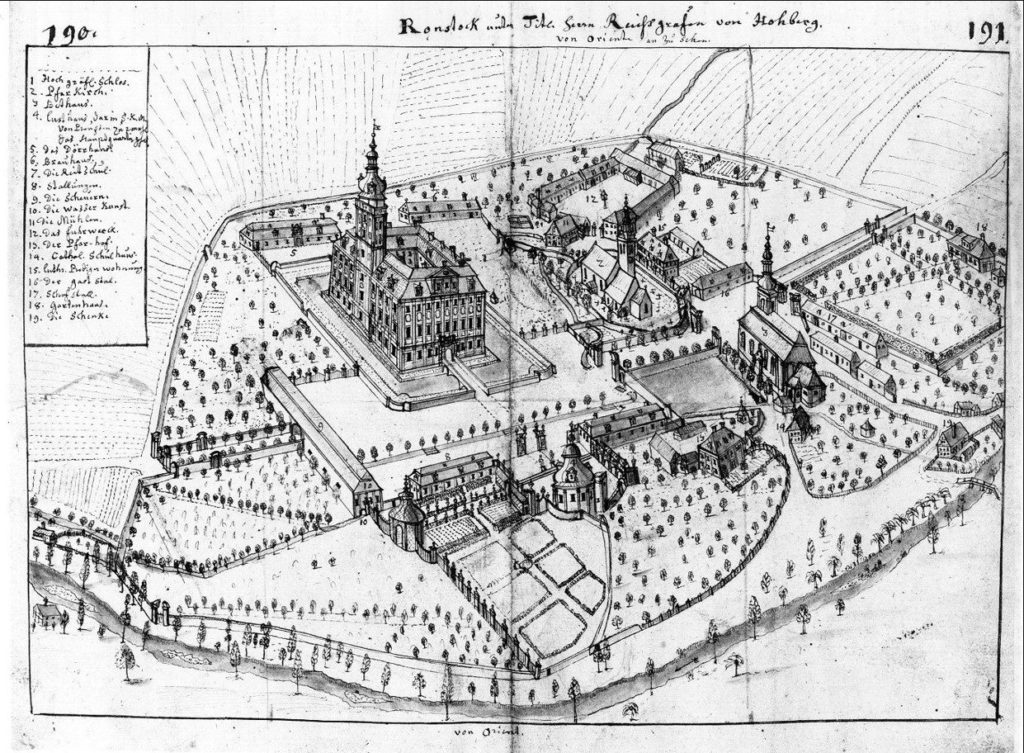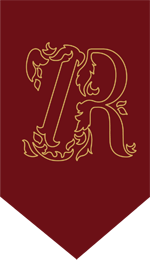The history of the Roztoka Castle goes back to fifteenth century.
Learn the history of the Castle by travelling back in time through the most important chapters in the history of this residence.

Starting from the end of the 15th century all the way until 1945, the Roztoka Castle was the seat of the count’s from the line of the distinguished Silesian family von Hochberg. The Hochbergs came to Silesia from Meissen already at the end of the 13th century. In the Silesian documents dating back to 1290, they are mentioned as von Hobergs. In the fifteenth century the family divided itself into a line of nobility based in Dobrocin near Dzierżoniów, an extinct baron dynasty from Buczynka near Lubin, a count line from Książ and Roztoka and, stemming from the latter, a prince’s line from Książ and Pszczyna. Almost all descendants of the Hochbergs from the 17th century were named Hans Heinrich, therefore they were numbered in the order of their birth, not reign. Even numbers are reserved for the representatives of the count’s line from Roztoka, to distinguish them from the dynasties ruling Książ Castle and Pszczyna
There was a water castle in Roztoka as early as fourteenth century. In 1374, Hentschel von Reibnitz was mentioned as the owner of the knights’ estate. His descendant Christoph II sold Roztoka on January 2, 1497 to Conrad I von Hochberg, the Head of the Grodziec castle and the Duchy of Świdnica-Jawor. After Conrad’s death, the castle was inherited by his son Georg, who introduced Protestant religion to his estate. In the 16th century, the castle was rebuilt in the Renaissance style. In the descriptions dating back to the Thirty Years’ War, there were two brick residential houses surrounded by a moat. One of them belonged to Conrad, and the other one to his brother Christoph. On March 5th, 1650, along with the death of Christoph- Conrad’s son, the Hochbergs on Roztoka expired. In his last will Christoph bequeathed the estate to his uncle Hans Heinrich I – Lord at Książ, causing the property to remain in the hands of the family.


A thorough reconstruction of the Renaissance castle into an impressive residence in Baroque style took place during the reign of Hans Heinrich III and was completed in 1725, as evidenced by the inscription preserved on a bell placed on the castle tower. The author of the reconstruction was probably the architect Feliks Anton Hammerschmidt, who worked in parallel on the Książ Castle. The main shape of the castle, along with the tower from the south side and an impressive two-storey ballroom with ornate plafond décor are maintained from that period until today. At the same time, to the east of the castle, a garden was established in accordance with the fashionable French garden art at that time, enriched with various park facilities, pavilions and garden sculptures, the still-present orangery and the so-called favorita – a kind of garden gazebo, used to rest and drink tea. Drawings made by Friedrich Bernhard Werner are a testimony to the appearance of the residence at that time.
During the Silesian wars, Roztoka found itself in the midst of the battle operations. After the Prussians won the battle of Dobromierz on the 4th of June 1745, King Frederick II chose Roztoka as his residence. Apparently he was so charmed by the palace garden that he slept in a tent under the stars. To commemorate his stay in Roztoka he presented the then owner of the castle Hans Heinrich IV with his portrait, which was the most valuable decoration of palace interior until 1945.
The nineteenth century was the prime time of the residence in Roztoka. The castle owes its current shape and décor to a thorough reconstruction, which took place in the 1870s. The author of the design was the court architect of the Hochbergs – Olivier Pavelt. The façade decoration was then renovated, however, leaving the main palace structure intact. The refurbishment encompassed palace interiors, now decorated with lavish tapestries, wood panels, elaborate stucco work and paintings. Only the ballroom was left with its original decoration – a magnificent, painted plafond. The client commissioning this reconstruction was the then-owner of Roztoka – Hans Heinrich XIV Bolko Count von Hochberg, a well-known composer at the time, a director of the Royal Theater, and later a director of the Court Opera in Berlin. Bolko arranged his own music salon in the elegant interiors of the first floor of the palace (piano noble), where his piano stood on the honorary place.
Concurrently to the reconstruction of the palace, an extensive English-style park was being arranged, its picturesque landscape constituting a natural cover of the entire establishment.

Count Bolko von Hochberg is one of the most prominent figures in the family history. In 1858, he inherited the Roztoka Castle and the adjoining properties in Nowy Zamek-Wierzchowice near Milicz. During the times of Count Bolko, the Hochberg family was at the pinnacle of their power and was among the most wealthy and influential elites of the Prussian aristocracy. During this period, the Roztoka estate covered 1,271 morga of land and brought almost 3,300 thalers of annual income. The memorable visit of two emperors in Roztoka Castle confirmed the unique position of the family. On September 17, 1890, during military maneuvers, the castle hosted the Austro-Hungarian Emperor Franz Joseph I and the German Emperor Wilhelm II.
In 1860, with significant financial input from Hochberg, a new Protestant church was erected in Roztoka, modeled after the imperial cathedral in Speyer. In the crypt of the church the Hochberg family mausoleums were organized. In 1889, at the count’s initiative, the first railway station was built in Roztoka, which was connected by a line with Strzegom, Jawor and Bolkow. The village gradually gained a very modern infrastructure, which could be envied by many a Lower Silesian town.

In difficult wartime years, the owner of the Castle in Roztoka was Count Hans Heinrich the 18th. Already in 1942, he had to make some rooms of the castle available for the needs of the Wehrmacht. The most interesting war episode in the history of the castle was when its premises were used as a museum depot for valuable books and archives evacuated, among others, from the Prussian State Library and many of Breslau’s archives and libraries. The Castle housed priceless paintings from the Silesian Museum of Fine Arts in Breslau and some of the collections removed from the nearby Książ. Before the Red Army entered Roztoka, the most valuable collections were personally secured by the main conservator of the Silesian Province, prof. Grundmann. In February 1945, the nearly 450-year history of the Hochbergs in Roztoka came to an end. The palace was damaged and the remaining equipment was looted.
From 1945 to 1973, the host of the castle was a steelworks factory “Pokój”, based in Ruda Śląska. The castle was used to arrange summer school for the children of the employees of the plant. Then, the historic estate was taken over by the Metalworks and Agriculturing Machines Factory “Agromet” from Jawor, which managed the castle until 1989. After this time, the residence was earmarked for the needs of the Volunteer Labor Groups. After the dissolution of the organization, the palace was rearranged into living quarters for 30 working-class families. In 1990, the monument was taken over by Dobromierz commune, which sold it into private hands two years later. Only the basic maintenance works were carried out in the castle building. Since then, the castle remains unused, falling victim to devastation of many valuable elements of interior design and equipment. Many of the estate’s decorations disappeared, such as, among others, beautiful tile stoves.
In the summer of 2017, inspired by sincere fascination and true love for monuments, the current owners have decided to buy the deserted castle and to make the revitalization of the monument a project of their lives. Aware of this undying feeling and thanks to the cooperation of many professionals and people of good will, the owners do not cease in their efforts to breathe a new life into these ancient walls. In front of our eyes, they are changing the face of one of the most beautiful monuments of Lower Silesia. Together with you, we want to write a new, wonderful chapter in the centuries-long history of the Castle in Roztoka!

